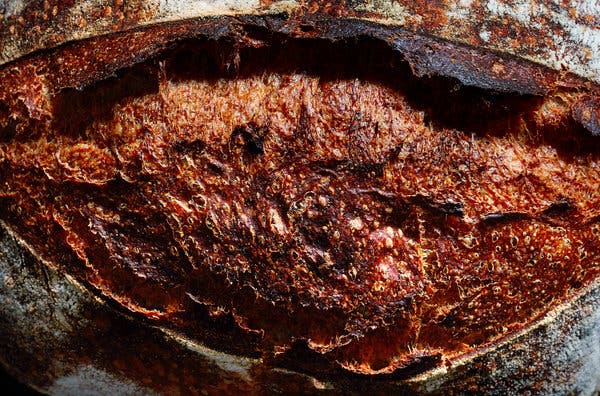Advertisement
Whether you’ve been baking sourdough for years and want to hone your skills, or you’re just trying to find your footing, we have recipes for you.

By Krysten Chambrot
Bread baking is a journey, and an extremely rewarding one at that. With each loaf, you’ll watch your skills grow and develop, and you’ll gain a keen understanding of the process. As you get better, you’ll know what to look for, and how to read your dough’s cues (it’s alive, after all!).
You may come to truly enjoy yeast-based breads, or you may give up yeast entirely and work exclusively with homemade leaveners, like sourdough starter. That starter may become a beloved pet, and your weekly loaves a cherished ritual.
But every journey has a beginning. Whether you’ve been making bread for years or you’re just trying to find your footing, here are some places to get started. (A note: Think of the order below merely as a suggested path, and the groupings as loose. You can start wherever you’d like, with whatever you’d like, depending on the amount of time you have to dedicate to the process and how confident you feel.)
NO-KNEAD BREAD If you want to try your hand at bread, but lack in confidence, Mark Bittman’s no-knead bread is a perfect place to start. True to its name, it doesn’t require any kneading, which is not only time consuming, it can also be a little tricky at first. This recipe, adapted from Jim Lahey of Sullivan Street Bakery, is one of The Times’s most popular, and with good reason. It’s pretty foolproof, yielding a low-rise loaf with minimal effort and equipment. You can start with the original, or, depending on what you have on hand, get to know its variations: the speedy, the whole-wheat. And, if you have a pizza peel, you can try your hand at this simple crusty bread.
QUICK BREADS And if you don’t have yeast? Try quick breads, which get their rise from leavening agents other than yeast and eggs, like baking soda or powder. Florence Fabricant’s beer bread calls for a bottle of beer: The blander, the better, she advises, so save the good stuff for celebrating your first loaf. But there are also biscuits and soda bread — all worthy yeastless carbs.
NO-KNEAD SOURDOUGHS Once you’ve gotten a handle on the basics, you have a whole world of bread available to you. You can branch into sourdough starter. A natural leavening agent made from just flour and water (and sometimes fruit juice, to help things along), it not only gives a powerful rise to bread, it also imparts a tangy flavor. You can make your own, though there’s absolutely no shame in buying starter online, or getting some from a friend. Use it in a sourdough no-knead bread, as part of pizza dough or in waffles or pancakes.
ENRICHED BREADS You can also explore enriched breads, which contain eggs; milk or butter, or both; and sometimes olive oil, too. They’re higher in fat, which can impede rise, but, more important, they’re delicious. Focaccia is a great place to start: It’s easily prepared on a rimmed sheet pan, and we have both sweet and savory versions. As is pizza dough in its many iterations: yeast-based and sourdough-based, quick and personal pan. Milk bread and brioche are also enriched doughs, as are challah, which can be flavored with olive oil or fennel and orange, and rich chocolate babka. And yes, at this stage, I’m not above counting cinnamon rolls as a bread. It’s foundational dough work.
SOURDOUGHS Maybe you’ve looked at some of the more intricate sourdough recipes, and felt intimidated. I hear you, but don’t be: Think of them not as instruction manuals, but as generous guides who just want you to thrive. In all honesty, this is the stage of bread baking where things can get especially tricky. You may get some gummy loaves, you may get big holes, or blowouts, in your crumb: It’s all OK! Your loaves are still edible, and mistakes are part of the process. They make the successes all the sweeter (all the more savory?).
Many bakers — myself included — have relied heavily on Tartine Bakery’s country bread. Developed by Chad Robertson, a well-known baker, it’s an excellent introduction to those bakery-level loaves, and if you already have an active, well-fed starter (no yeast necessary!), you’re already a significant part of the way there. Just skip to Step 3.
But if you’re someone who benefits deeply from visual instruction and maybe a little hand-holding, Claire Saffitz’s guide is for you. Her step-by-step guidance, complete with animated GIFs, not only explains the hows, but the whys, of getting that deep-brown exterior and perfectly pocked crumb.
The key? Look for a bubbly, aerated dough that feels like whipped cream. You’ll know it when it when you see it — at this point, baking bread is as much about observing your dough and looking for its cues, as it is following instructions. (Full disclosure: I was the editor on this guide, and it has totally changed how I bake bread. I’m not just the president, I’m also a client!)
You’ll want to set aside three days for the process, but only one day is a heavy lift. And a tip: If you don’t have bannetons, the baskets used for bread proofing, don’t worry. You can always use mixing bowls.
Baking off a beautiful naturally leavened loaf from just flour, water and salt never gets old. And mastering the showstopping loaf doesn’t mean your journey is over. There’s so much more to learn and observe: You’ll be able to talk about alternative flours and hydration, dough temperature and scoring techniques. Is it nerdy? It is, but there are worse ways to pass the time.